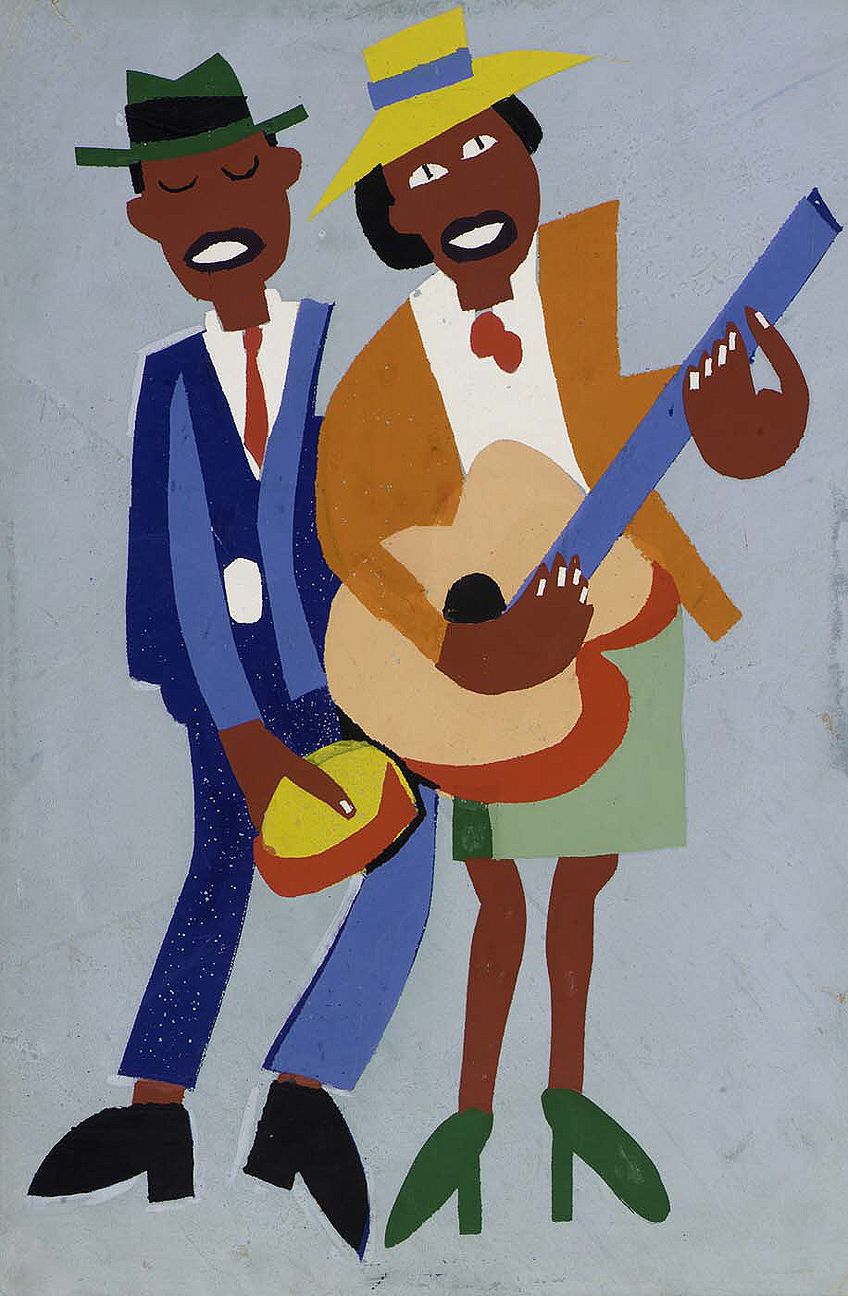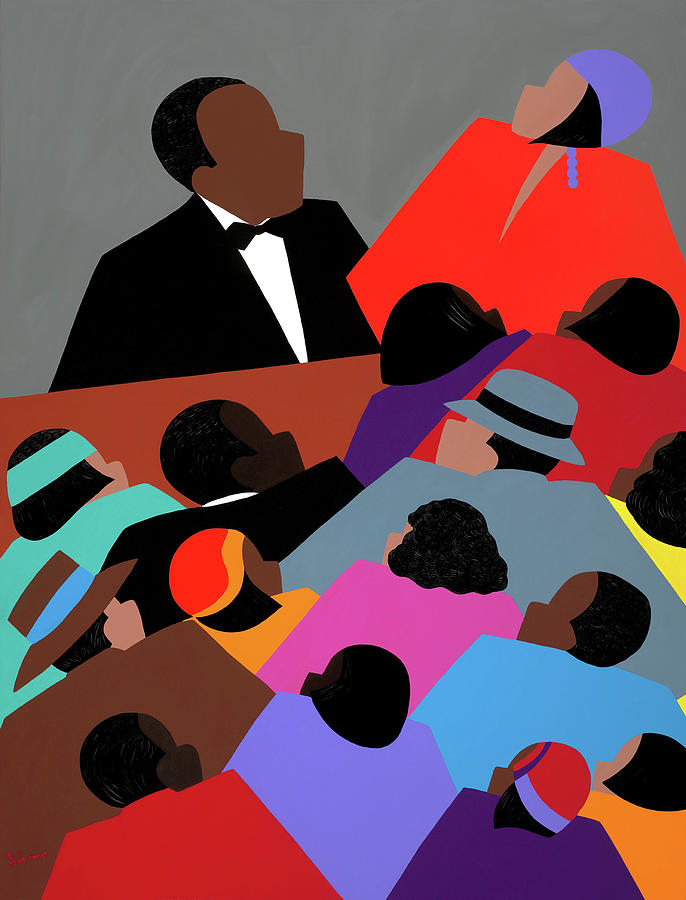
harlem Harlem renaissance artists, African american quilts, African
For most people, Blues is an iconic Harlem Renaissance painting; though, Motley never lived in Harlem, and it in fact dates from his Paris days and is thus of a Parisian nightclub. The tight, busy interior scene is of a dance floor, with musicians, swaying couples, and tiny tables topped with cocktails pressed up against each other in a vibrant, swirling maelstrom of music and joie de vivre .

He Painted the Feverish Nights of the Harlem Renaissance
Summary of Harlem Renaissance Art. The term Harlem Renaissance refers to the prolific flowering of literary, visual, and musical arts within the African American community that emerged around 1920 in the Harlem neighborhood of New York City. The visual arts were one component of a rich cultural development, including many interdisciplinary.

Harlem Renaissance Art Harlem renaissance art, Harlem renaissance
Harlem Renaissance. Aaron Douglas, The Judgment Day, 1939, oil on tempered hardboard, Patrons' Permanent Fund, The Avalon Fund, 2014.135.1 Years after the 1927 publication of God's Trombones: Seven Negro Sermons in Verse, Aaron Douglas painted new works of art based on his original illustrations for the book.The artist's use of complementary colors (purple and yellow/green) combined with.

He Painted the Feverish Nights of the Harlem Renaissance
Harlem art stands for all things to do with the Harlem Renaissance and its expression. Artists expressed themselves in a wide variety of modalities, namely, theater, film, poetry, literature, music like Jazz and the Blues, and the visual arts like painting in the form of murals, sculpture, photography, printmaking, and book illustrations.

Harlem Renaissance Summary, Top Artworks & Artists everything with
The Harlem Renaissance was a rich cultural and social development that not only transformed the art world, but society too. It was a golden age in African American culture, as the minority black population were instilled with a pride, social consciousness, and self-determination over the black experience and paved the way for the Civil Rights Movement of the 1950s and '60s.

blackhistoryalbum Art of the Harlem Renaissance... Black Artists on
The Harlem Renaissance was an influential movement of African-American art, literature, music, and theatre. The movement emerged after the First World War, and was active through the Great Depression of the 1930s until the start of the Second World War.

Sign in Jazz art, Harlem renaissance artists, African american art
In February 2024, The Metropolitan Museum of Art will present the groundbreaking exhibition The Harlem Renaissance and Transatlantic Modernism.Through some 160 works, it will explore the comprehensive and far-reaching ways in which Black artists portrayed everyday modern life in the new Black cities that took shape in the 1920s-40s in New York City's Harlem and Chicago's South Side and.

Background Information Jazz artwork, African american history, Harlem
Harlem Renaissance, a blossoming (c. 1918-37) of African American culture, particularly in the creative arts, and the most influential movement in African American literary history. Learn more about the Harlem Renaissance, including its noteworthy works and artists, in this article.

tumblr_no3s2zLRsI1r70t2xo1_1280.jpg (1197×1600) Harlem renaissance
The Harlem Renaissance denotes a specific period of black cultural flourishing, which began in the early 1920s and ended just before World War II. While white historiography often typecasts the movement as a moment of "birth," black artists were in fact combining European modernism with centuries of formal innovation within African-American and African art.

Harlem Renaissance Art A Timeline of Art in the Harlem Renaissance
Archibald Motley (1891-1981) was one of the most important figures associated with the Harlem Renaissance and is best known as both a master colorist and a radical interpreter of urban culture. Archibald Motley: Jazz Age Modernist is the first full-scale survey of his paintings in two decades. The exhibition offers an unprecedented.

Harlem Renaissance aka Jazzed Painting by Synthia SAINT JAMES
The Harlem Renaissance was likely one of the most pivotal moments in art history for the United States for a number of reasons. The movement began in the early 1920's and would last for a few decades into the 1940's, according to some art historians.. Following the Harlem Renaissance, Douglas went on to teach art at Fisk University where.

South Sound Arts etc. Alec Clayton
The Harlem Renaissance was a vibrant blossoming of literature, art, and music within the African-American community that began about 1920 in New York City's Harlem district. Visual art in the Harlem Renaissance was one component of a thriving cultural development that included several multidisciplinary partnerships, in which artists collaborated extensively with publishers, writers.

UTA September 2010 Harlem Renaissance Influential Artist of the Harlem
Summary of Aaron Douglas. In both his style and his subjects, Aaron Douglas revolutionized African-American art. A leader within the Harlem Renaissance, Douglas created a broad range of work that helped to shape this movement and bring it to national prominence.Through his collaborations, illustrations, and public murals, he established a method of combining elements of modern art and African.

The Harlem Renaissance was an intellectual revival of African American
Another Harlem Renaissance-era kingmaker was the writer Alain Locke, dubbed the movement's "dean" for his mentorship of figures like Hughes and Hurston and his insistence that Black artists.

Art and Literature During the Harlem Renaissance Idea File KET
The most celebrated Harlem Renaissance artist is Aaron Douglas, often called "the Father of Black American Art," who adapted African techniques to realize paintings and murals, as well as book.

Harlem Renaissance art Google Search Harlem renaissance artists
Up until the Harlem Renaissance, African American faces rarely appeared as the central subject of visual art. Barthé's art and interest in the male figure was informed by his identity as a gay man, who according to the times was constrained in disclosing this part of his life openly, although he did find fellowship and love interests among the period's artists and intellectuals.